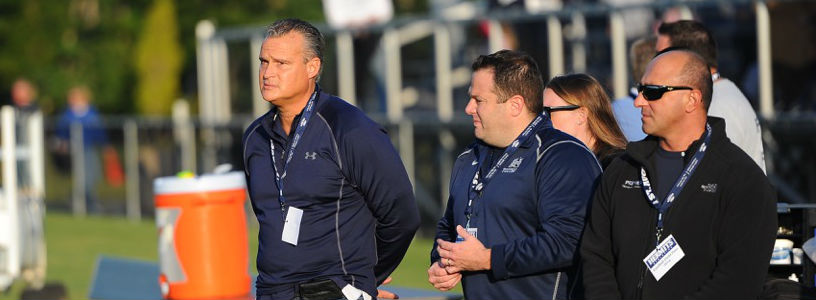DR. DWYER IS LEADING BY EXAMPLE IN SOUTH JERSEY
Al Thompson
 Dr. Thomas Dwyer (left) is a familiar sight on sidelines of sporting events throughout the South Jersey area volunteering his time as team Physician to several schools. Photo by Andy Lewis / contrastphotography.com.
Dr. Thomas Dwyer (left) is a familiar sight on sidelines of sporting events throughout the South Jersey area volunteering his time as team Physician to several schools. Photo by Andy Lewis / contrastphotography.com. It is believed that when you see a successful organization, the reason for that prosperity starts at the top.
If that’s true, Thomas A. Dwyer, President/CEO of Premier Orthopaedic Associates is a major reason why this medical group has become so respected over the last two decades.
Dr. Dwyer, M.D., FAAOS, Orthopedic Surgeon, is a specialist in Orthopedic and Sports Medicine and has dedicated himself to working with athletes and active people of all backgrounds, ages and gender.
From a stint as assistant team physician for the Pittsburgh Steelers to working with semi-pro football teams to volunteering as the team physician for the Cumberland Community College Dukes, St Augustine Prep and Buena Regional High School.
Dr. Dwyer also sees student/athletes from other high schools including Vineland, Delsea, (Arthur P. )Schalick, Millville and Pennsville.
Dr. Dwyer has been part of the sports fabric of South Jersey his entire life.
“I’m in all of them in South Jersey,” said Dr. Dwyer.
This is part one of a two-part interview with Dr. Dwyer on his practice and views on modern medicine.
ABOUT THE DOCTOR
We are talking about a serious, life-long sports enthusiast.
Dr. Dwyer attended Christian Brothers Academy in Lindcroft, New Jersey where he
was a three-sport athlete all four years: Soccer (goalie), wrestling (145 to 177 pounds) and baseball (first base).
Dr. Dwyer has also been a dedicated weight lifter his entire life and trains passionately today.
His daughter, Lauren, is a standout athlete at Buena High School, especially excelling in softball where she has been recognized as national-level player, receiving scholarship offers from many elite D-1 programs. The pitcher/first baseman will likely play at the University of Delaware, Rowan or Rutgers.
It was obvious that sports was going drive Dr. Dwyer his entire life, but which way? Would he go on and play college sports? Then get into coaching?
The young Dwyer was bright and wanted a career in medicine. He had a major decision to make as an 18-year-old who was blessed with many tempting options.
“When I got out of high school, I recruited to play baseball for Colgate,” Dr. Dwyer said at his facility in Mullica Hill. “At that time I decided I wanted to be an orthopedic surgeon. I wanted to be a doctor. I’ll put it that way. I had my fair share of broken bones and injuries like everybody else. I decided to go to Notre Dame. The academic curriculum is rigorous out there. It was readily apparent to me that there was no way that I was going to be able to play any sport other than intramurals. There was no way I was going to be able to do that and maintain the academic standards that I needed in order to get into medical school.”
Dwyer graduated from Notre Dame for Pre-Med then earned his medical degree at SUNY, Health Science Center at Syracuse, Syracuse. Dwyer interned at the University of Connecticut Health Science Center, did his residence at the University of Connecticut Health Science Center and his followed his Fellowship at Orthopaedic Research of Virginia, Arthroscopic Shoulder & Knee Reconstruction/Sports
Medicine.
Dr. Dwyer has been a staple in South Jersey for two decades with his private practice as a highly rated orthopedic surgeon and is affiliated, according to public records, with 11 hospitals in the area.
Dr. Dwyer is a guest teacher at many area Universities including the University of Medical and Dental (PCOM) and Drexel in Philadelphia. He also teaches in an office environment and the operating room.
MISSION STATEMENT
Premier Orthopaedic Associates has four locations throughout South Jersey including Vineland, Mullica Hill and two in Elmer. Dwyer talked about his company’s role in
the area.
“This organization exists to provide high quality, state-of-the-art orthopedic service line by University trained, Fellowship educated specialty surgeons to the residents and the county we serve,” he said. “Our motto is to place our patients first, practice with integrity and continue to pursue orthopedic excellence.”
The prestigious staff of Premier Orthopaedic Associates includes:
* Fred McAlpin, III, D.O., FAOAO, Orthopedic Surgeon Orthopaedic Surgeon, Sports Medicine Specialist.
* John B. Catalano, M.D., FAAOS, Orthopedic Surgeon Orthopaedic Surgeon, Trauma Reconstruction Specialist.
* Richard C. DiVerniero, M.D., FAAOS, Orthopedic Surgeon Orthopaedic Surgeon, Orthopaedic Generalist.
* Rahul V. Shah, MD, FAAOS, Orthopedic Spine Surgeon Orthopaedic Spine & Neck Surgery
* Kimberley Y. Smith, M.D., FAPMR & FAAPM, Pain Management Specialist Pain Management Specialist.
* Peter A. Sarkos, D.O., Orthopedic Hand and Micro Vascular Surgeon Orthopaedic Hand & Micro Vascular Surgeon.
* Vincent N. Disabella, D.O., FAOASM, Internal Sports Medicine Sports Medicine, Concussion Symptoms.
* Chiara Mariani, M.D., FAAPMR, Pain Management Specialist Fellowship Trained Physical Medicine and Rehabilitation Specialist.
* Eddie Wu, D.O., Orthopaedic Surgeon Orthopaedic Surgeon, Total hip and knee replacement specialist.
NEW WAYS TO TREAT PATIENTS
Medical advances are being made every day and in every field. Dr. Dwyer talked about improvements in orthopedic care and surgery over the past 15 years.
“In general, for orthopedic surgery, surgical procedures, most, if not all orthopedics have gone from open surgery to minimally invasive to arthroscopic,” Dr. Dwyer said. “When you compare today to say 15 years ago, we didn’t do any arthroscopic treatment of small joints such as fingers, toes, wrists, elbows or ankles. That type of surgery was characteristically done in an open fashion. Today, 15 years later, we routinely perform all those procedures arthroscopic-ally.
“With regard to the shoulder and knee, which are the two most commonly injured joints in the sports medicine perspective, the same trend is also arguable.
“The shoulder for example, 15 years ago, rotator cuff repairs and stabilization procedures for labral tears and biceps injuries were done open,” Dr. Dwyer continued. “Today those operative procedures are done entirely through the arthroscope.”
Dr. Dwyer said there are even more advances in arthroscopic treatments that patients and serious athletes are starting to trust.
“Probably the most significant advancement has to do with cartilage restoration or enhancement procedures,” Dr. Dwyer said. “Fifteen years ago, if you had an articulate cartilage problem in any joint – specifically the knee or shoulder – once the lining of the bone, the articulate cartilage was damaged, that would lead to progressive Osteoarthritis. Today we have a number of interventions available in orthopedics that allows us to provide cartilage preservation or restoration techniques through cartilage
transplant surgery that was not available 15 years ago.
“We can now remove the area of diseased cartilage and then transplant new cartilage in there, either as an autograft procedure, where we harvest articulate cartilage from one part of our body – usually in the same joint that is not interactive. Or you can use allografts where you take live tissue from the bone, much like a liver transplant or a kidney transplant.
“For years we’ve used dead cadveric tissue, for instance ACL reconstruction, things of that nature where this tissue has either been preserved or irradiated,” Dr. Dwyer continued. “But for articulate cartilage transplants now we’re using fresh tissue … more similar to, for example, a liver transplant … of course the risk of rejection are also possible but not anywhere near as dramatic.”
Part two will focus on Dr. Dwyer’s look to the future in sports medicine and spine injuries, stem cell research, the PED crisis that goes hand-and-in hand with concussions and how the medical community can make sports safer for all levels.
Email Al Thompson at the.magazine2@footballstories.com












